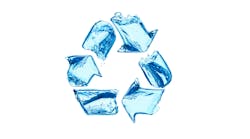Water is conserved in the grand world scheme. Water availability and shortages for domestic uses that are often attributed to climate change are often driven by water’s historic local presence versus the increasing demands caused by population migration to cities and commercial activities that increasingly tax the available supplies. So, human interventions to enhance the natural water cycle become more important to reduce unnecessary uses and to expand the real water availability by eliminating single pass and introducing multiple-pass use prior to discharge. These include several types of recycling ranging from agricultural irrigation and food processing, industrial cooling and other processes, nonpotable and potable domestic uses, and ultrahigh-quality industrial uses as in the electronics chips industries.
Water in a river that is not withdrawn and temporarily used for some domestic or industrial purpose will just continue downstream and eventually reach the oceans, probably only providing some ecological benefit along the way. Water that is not consumed on-site will be returned to the environment, sometimes in a different location and sometimes in different (better or lesser) quality than when it was withdrawn. So, the issues of water consumption and conservation have mostly location- or site-specific considerations.
Reducing wasted water and improving the efficiency of water use in manufacturing is a no-brainer. Although it is often touted by industries and advocated by politicians and environmental groups as essential for reduced consumption of water to preserve natural sources, it usually is best supported because it makes current and future economic sense in many areas. In water-limited areas, it is essential to minimize wasteful water consumption, and that is the case in some locations and for some industries. Local and national politics can also be a major driver. In all locations, the energy cost of water use is the dominant driver for conservation and reuse.
High water-consuming industries
Beverage production
Water is used in beverage production for cleaning and sanitizing processes, cooling processes, heating processes, sanitation and landscaping, in addition to the water that becomes the product. Beverages include beer, bottled water, carbonated and still soft drinks, juices, distilled spirits and wines. There are at least 1,400 to 1,600 significant beverage production facilities worldwide. By its nature, beverage production is a high water consumer, and the product beverage is usually substantially used outside of the production watershed, so there will be a net transfer of limited groundwater, if used, from the watershed area. That adds a political and emotional dimension to the water usage controversy in some locations. Withdrawals are being regulated relative to returns, in some areas, both in quantity and quality.
Beverage companies have been increasingly sensitive to water access, production, local criticisms and availability issues, and they have taken steps to reduce the quantity of water needed to produce a quantity of beverage.
Data from a 2012 worldwide survey indicated that water usage was reduced from 776 billion liters in 2009 to 739 billion liters in 2011. Production increased from 254 billion liters to 268 billion liters in that time span, and the water use ratio was reduced from 3.06 liters of water/liter of product to 2.76 liters of water/liter of product. Carbonated beverages and bottled waters are the two largest segments. Carbonated water use ratios were reduced by 9 percent, and bottled water usage ratios were reduced by 5 percent. Breweries have much larger use ratios, and they were reduced from 4.53 to 4.00 liters of water/liter of product. Distillery usage ratios for a smaller volume were reduced from 38.35 to 34.55 liters of water/liter of product. These usage ratio reductions have further improved since 2011.
Industrial water use in aluminum production
Aluminum production consists of bauxite mining and alumina preparation and the electrolytic reduction process that produces aluminum metal. Water use in bauxite refinement includes cooling the process water solution prior to precipitation and concentration by evaporation. These are energy and electric power intensive. Evaporators are becoming more efficient. In the aluminum reduction/production processes, gas scrubbers are a principal energy and water consumer, and some plants condense and recycle the water.
“Water use in bauxite refinement includes cooling the process water solution prior to precipitation and concentration by evaporation.”
There are many worldwide process steps, conditions and electricity sources, so it is difficult to arrive at a specific comparison of water consumption per pound values. Reports on U.S. plants in 1956 determined that water requirements of alumina plants ranged from 0.28 to 1.1 gallons per pound (1.05 to 4.2 liters/pound) of alumina with an industry average of 0.66 gallons (2.5 liters) per pound. In the 2016 worldwide assessment, water requirements for aggregated aluminum production ranged from 1.24 to 36.33 gallons (4.7 to 137.3 liters) per pound of aluminum production with an average of 14.62 gallons (55.3 liters) per pound. If China were excluded, the values were about halved. Recycled aluminum versus virgin origin and hydropower versus other electricity sources have significant energy and water demand differences.
Industrial water use in iron and steel production
Iron and steel production begins with iron ore mining and concentrating and proceeds to the integrated steel production plants that include coking, furnaces and rolling mills. In addition to iron ore production, gross water use in integrated U.S. steel plants ranged from 11,200 to 110,000 gallons/ton of ingots (42,560 to 415,800 liters/ton) in 1958. A survey of 20 worldwide plants in 2011 showed that they ranged from about 132,000 liters/ton (converted from metric) to virtually zero/ton. The average water intake was about 25,000 liters/ton, the discharge was 23,400 liters/ton with lost consumption approaching 3,000 liters/ton — much of which is due to evaporation.
In water-shortage areas, zero discharge is becoming more common to encourage reuse. Reuse involves cooling and desalination, which are energy intensive. Concentrated salts are usually dewatered and landfilled because of low quality.
Water management in the auto industry
Toyota is an example of the automobile industry’s concerns about water management by establishing goals for the future. Its water position by 2050 includes four parts:
• Eliminate water withdrawals from operations.
• Establish closed-loop systems with 100 percent recycled/reused water.
• Engage with communities and nonprofit organizations to conserve water.
• Assist major suppliers and dealers with adopting the same goals.
Toyota’s report projects a 30-percent increase in global water demand and acknowledges that about 70 percent of worldwide water is used for food production and only 10 percent for domestic purposes, and drinking water and food preparation accounts for only 1 percent.
Conclusion
Many, if not most, industries are taking positive steps to reduce water waste due to inefficiencies that were previously allowed because of the historically low cost and generally high availability of natural water. Beyond water’s availability, the energy cost of water usage and movement is a critical element of the dollars-and-cents issues of water for production. Seawater for desalination and domestic wastewater for recycling are almost unlimited in their accessibility, but they all have a rising cost. Processes that use less water as well as recycle will continue to be more widely applied. In addition, the regulatory cost of wastewater treatment for discharge and costs of discharge permits will continue to be a burden.
“Beyond water’s availability, the energy cost of water usage and movement is a critical element of the dollars-and-cents issues of water for production.”
It is plausible that industrial water consumption will continue to become more efficient because industries are identifiable and have less political cover than agriculture, which is the largest water consumption segment by far. While certainly essential, it is important that improvements in water usage efficiencies become more widespread and reflect the practices already applied successfully in arid areas, as well as production and biotechnology improvements that will permit greater food production with less water use. It will be necessary for all of the water consumption segments to contribute in a substantial way to achieve more efficient multiple-usage targets, especially in water-shortage areas.
References
1. Water Management in the Steel Industry (2015). World Steel Position Paper. World Steel Association. https://www.worldsteel.org/en/dam/jcr:f7594c5f-9250-4eb3-aa10-48cba3e3b213/Water+Management+Position+Paper+2015.pdf.
2. Water Position Toyota. https://www.toyota.com/usa/environmentreport2017/water.html.
3. Water Requirements of the Aluminum Industry. H.L. Conklin. Geological Survey Water Supply Paper 1330-C. US Government Printing Office, 1956. Pubs.usgs.gov/wsp/1330c/report.pdf.
4. Water Requirements of the Iron and Steel Industry. F.B. Walling and L.E. Otts. Geological Survey Water Supply Paper 1330-H. US Government Printing Office, 1967. Pubs.usgs.gov/wsp/1330h/report.pdf.
5. Water Scarcity Footprint of Primary Aluminum. Int. J. Life Cycle Assessment. Vol. 21(11) 1605-1615. November 2016.
6. Water Use Benchmarking in the Beverage Industry. Beverage Industry Roundtable. https://www.bottledwater.org/files/BIER Water Use Benchmarking Report 2012.pdf.
Joseph Cotruvo, Ph.D., BCES, is president of Joseph Cotruvo and Associates LLC, water, environment and public health consultants, and technical editor of Water Technology. He is a former director of both the EPA Drinking Water Standards and the Risk Assessment Divisions.


